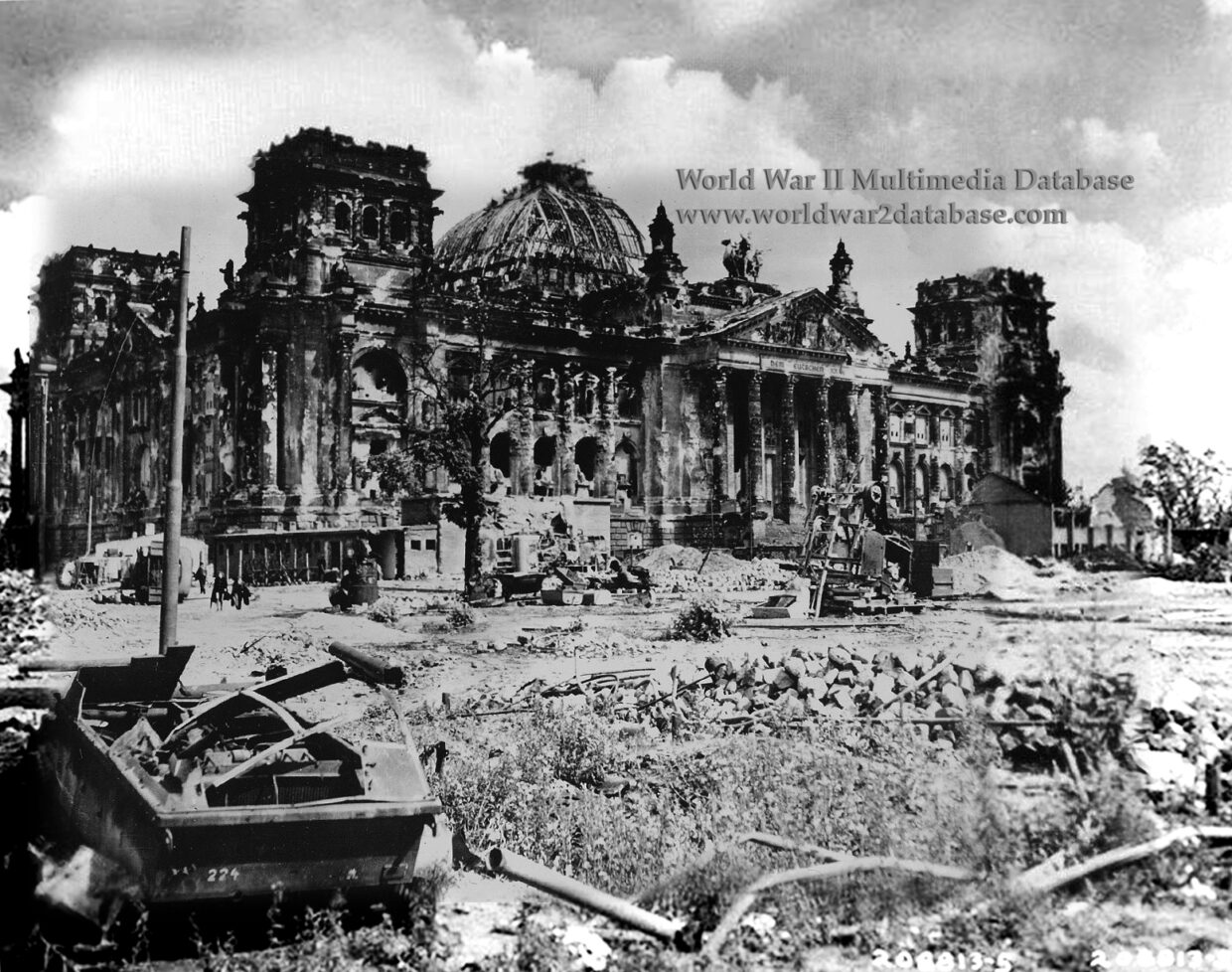| The Reichstag in summer 1945, with a Schwerer Ladungstrssßger Borgward B IV Ausfuhrung C Sonderkraftfahrzeug 301 (“Heavy Explosive Carrier Borgward B IV Model C Special Ordnance Vehicle 301“) with six Raketenpanzerbuchse (“Rocket Tank Rifle“) 54/1, a rocket commonly known as the Panzerschreck (literally “armor fright“ or “tank fright“), in the lower left. These Panzerjager Wanze (“Tank Destroyer Bug“) were the last supply of vehicles available, and fifty-six were converted from remotely piloted vehicles that dropped explosives on fixed positions or munitions supply vehicles. Captured universal carriers and Kubelwagens were also equipped with Panzerschrecks. The Borgwards and Kubelwagens were attached to scratch units to take on Soviet tanks. The 3.3 kilogram (7.3 pound) warhead had a 180-meter range and could pierce 200 mm (7.8 inches) of armor. All six rockets were fired at once; a hit, though rare, would disable any Allied tank. The area around the Reichstag was left uncleared for years, and this particular Borgward was left rusting in place until at least 1948. Note the two women walking near the Reichstag; the area was a popular meeting place for black marketeers. They would meet behind the Reichstag between the building and the Spree River. Berliners would trade shoes, binoculars, furniture, and any tangible goods for food. Foreign money and cigarettes were a common currency. Some police raids arrested 2,000 people at a time, but as ration supply fell, more and more Berliners traded goods for food. Scrappers stripped the Reichstag of metal, including many centuries-old metal artworks, because scrap could be sold for enough currency or could be used to rebuild. Vehicles like the Borgward were too heavy to be completely dismantled and took years to be broken up. Red Army Lieutenant Vladimir Gelfand (March 1, 1923 – November 25, 1983) recorded in his diary, “I hitch-hiked to Berlin. I got out at the market near the Reichstag and stayed on the fringes, so as to more easily avoid any patrols. I purchased a few trifles (a fountain pen, batteries) and soon I had spent all my money. Then I decided to sell the watch I had bought from the Rilewskis to a fellow officer, with whom I had travelled from the regimental headquarters, since he was due to go home. I sold it to him for the same price as I had bought it, and with that I had one and half thousand marks in my pocket.“ Gelfand avoided Red Army patrols to purchase from the Alexanderplatz‘s black market. “The crowd was dispersed several times, and several times soldiers with ‘MP‘ armbands came and looked me over – even their commander, and officer. But they simply couldn‘t find anything wrong. Meanwhile, I had already succeeded in purchasing a shirt, a leather jacket, three pairs of men‘s socks and some gloves.“ Many of the black market customers, at least at the beginning, were Red Army soldiers, who were allowed to send home a few pounds of items every month. Undoubtedly, the desperate and underfed Berliners were exploited by the occupiers, of whom the Americans had supplies of food and cash, but the French, British and Soviets had more than the civilians and could steal or barter at an advantage. The black markets operated throughout the Berlin blockade. | |
| Image Filename | wwii0271.jpg |
| Image Size | 1.13 MB |
| Image Dimensions | 1555 x 1227 |
| Photographer | Unknown |
| Photographer Title | Signal Corps |
| Caption Author | Jason McDonald |
| Date Photographed | August 01, 1945 |
| Location | Reichstag |
| City | Berlin |
| State or Province | Berlin |
| Country | Germany |
| Archive | National Archives and Records Administration |
| Record Number | 111-SC-208813-5 |
| Status | Caption ©2013, ©2024 MFA Productions LLC Image in the Public Domain |

Author of the World War II Multimedia Database

